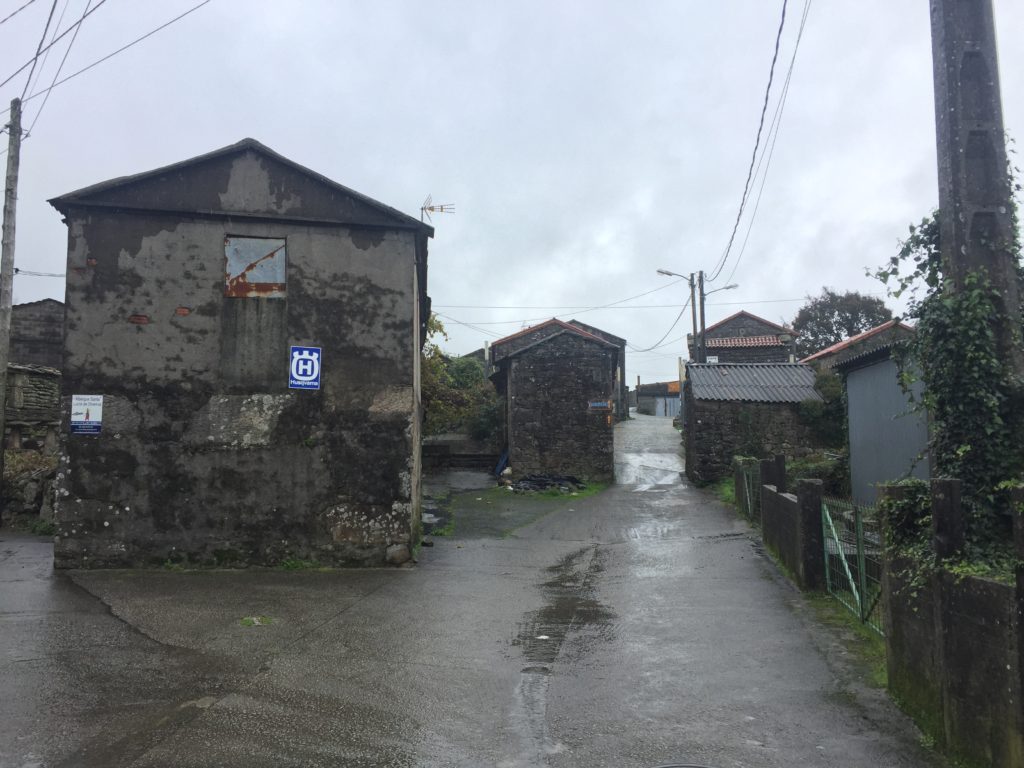
By the time I’d finished my second day’s walk I was really starting to hate the Camino Finisterre. I was also really starting to hate life. The first time I had walked that path, back in 2004, I thought it was long and monotonous, isolated and lonely, tiring and dull, but at least it was a new and novel experience. Walking in the footsteps of ancient pilgrims and seeing the sun set at one of Europe’s most westerly points would be a perfectly fitting way to end my epic journey which had began nearly 900 KM before in the Pyrenees. Second time around I wanted to walk as far as the sea again. There was something very conclusive about reaching a point where I could go no further. Only this time around I hadn’t planned on having to walk in rain of such ferocity it could wash away my will to live, let alone my desire to walk.
October 24th, 2013, is a date that has became seared, or soaked, into my memory. My 35 KM march in the rain that day, from the small town of Negreira to the negligible hamlet of Olveiroa, along the flooded roads and drenched woodlands of rural Galicia, was the greatest test of character I had confronted on my camino adventures to date. I started out in the early dawn, nearly 9 AM in October in that part of Spain. Two of my travelling companions, a young Canadian couple called Emilie and David, looked at the weather and chose to not to walk anymore. They said they’d meet me the following evening in Finisterre, which they were going to reach by bus. Another friend of ours, an American called Janet, decided she’d venture on after eating a hearty breakfast. I felt I had no choice by to keep going as well. Staying true to my belief that whatever the weather on the Camino I would walk, I left the relative comforts of the albergue (I say relative as there had been an outbreak of bedbugs there that night) and headed out into the unfolding climatic terror outside.
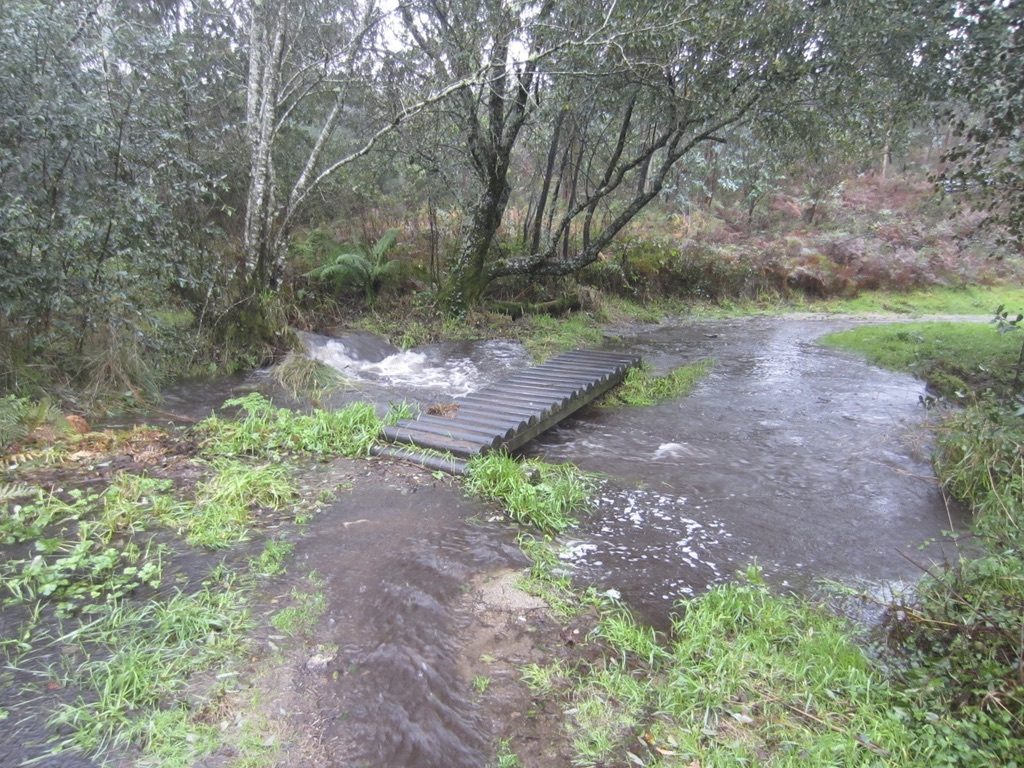
The day was god awful at first, and got progressively worse as the rain intensified and beat down on the dogged pilgrims with no mercy or respite. Walking headfirst into this unrelenting, driving rain, where the air around me was saturated with moisture, my boots were waterlogged, my backpack and all its contents burdened me down from taking on more water than the sinking Titanic, and I had no more than a handful of nuts to sustain me over six hours, proved to be the ultimate trial of body and soul. The weather killed some of my electrical equipment, and I had to sleep in a saturated sleeping bag that evening, knowing I had an equally arduous journey the next day and the forecast again was for rain.
What I didn’t realise as those unremitting deluges were pushing, punishing and beating me to within an inch of my sanity, was that the symphony of climatic horrors was the perfect tonic for shaking off the depression and mental fog that had been hovering over me for months. When I reached Olveiroa that evening, as wet as it was possible for anyone to be without falling into the sea, I had arrived at a place of redemption. Redemption that evening was simply a hot shower and change of clothes from ones that were saturated into slightly ones slightly less so, but sometimes that’s all the salvation one needs.
TO THE END OF THE WORLD
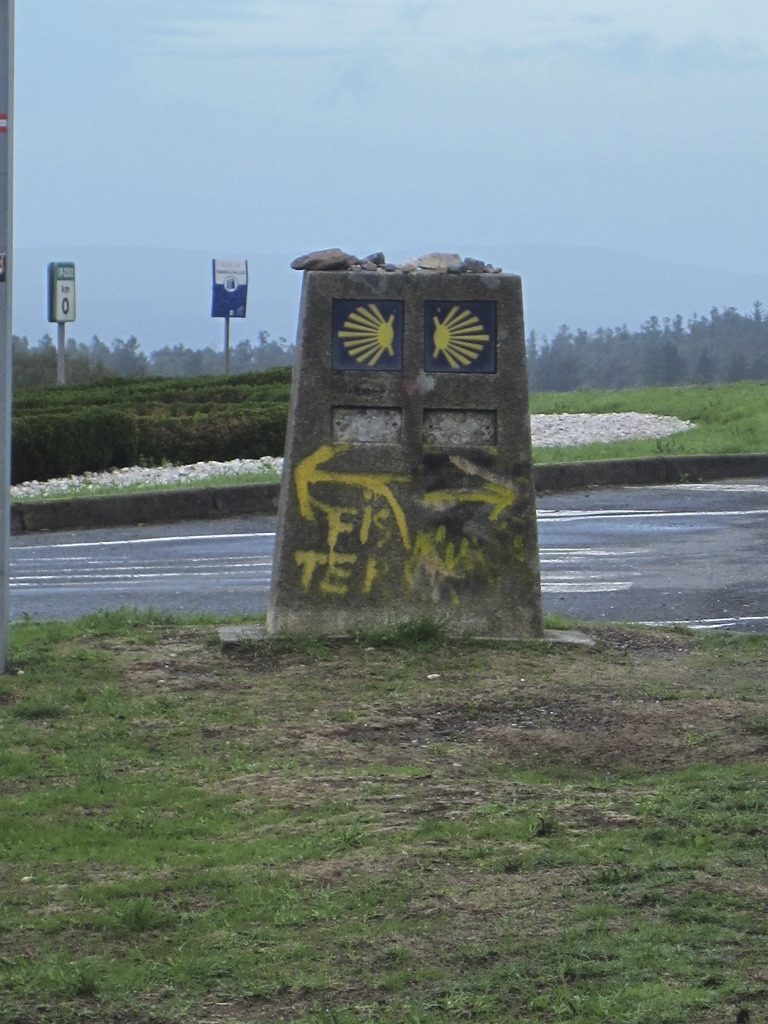
There is often a flurry of excitement in Olveiroa, as Finisterre is for many pilgrims the next and final stopping point on their journey. In 2004, those running the cosy rustic albergue in Olveiroa served up a big pot of garlic soup, which we all shared, along with whatever other foodstuffs we had carried with us from the previous town as there was no place to stock up on supplies around here. The Camino was still somewhat raw and rugged then. It was increasing in popularity, but it was still a hidden gem. When I walked it for the second time nine years later, after Martin Sheen’s overly romanticised film had inspired thousands of others to do it, the Camino had become a lot more regulated and commercialised. The garlic soup had gone, but a few new restaurants had opened up in Olveiroa, bringing new life and prosperity into this isolated part of Spain.
When I woke the next morning it was dry, but there was a threat in the air. I cautiously left Olveiroa behind, and walked along a road that winds over a mountain dotted with windmills, and through the wooded countryside until it reaches a fork in the road. To the right the path leads to a fishing village called Muxia, while the left stretched towards Finisterre, the end of the world. A cafe at that split advertises that it’s the only point to get any refreshments for the next 17 KM. What lies beyond is a vast empty plain of nothingness, as isolated as anything a pilgrim who has walked the Camino Francés will have seen. But for the first time they will get to see one of the most refreshing and uplifting sights known to humanity: the sea.
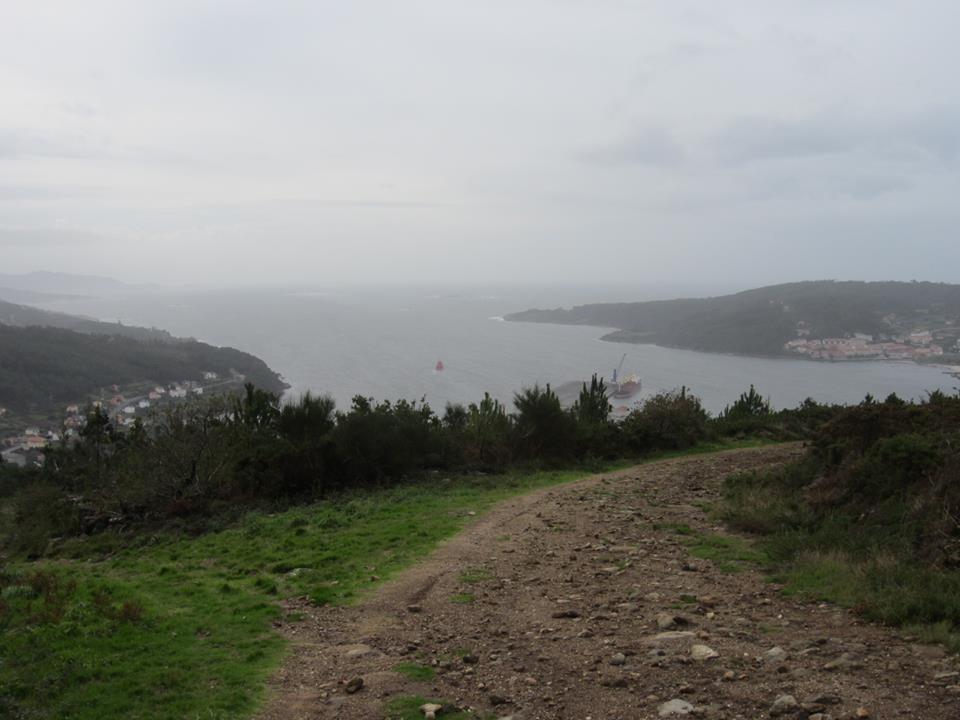
As I was still recovering from the previous day’s heavenly pounding, and my clothes, boots and backpack were still drenched, I was already feeling very maritime by the time the sea appeared on the horizon. Mercifully, for the first portion of that day’s walk the rain held out. Along the road I bumped into a Canadian colleague called Gary, who I’d first met along the path a few days earlier. He commented, “Did you see the rain yesterday?” I looked at him knowingly. No words needed to be said, but there was a feeling of mutual respect between those of us who had endured that devilish deluge. Many think of the Camino as a life changing experience, consisting of leisurely walks on sunny days, and communal dinners with people from different countries experienced against a backdrop of Iberian mysticism. Of course it is all of those things, but sometimes the Camino was sheer hell. Those of us who navigated its underworld held our fellow travellers in very high regard indeed.
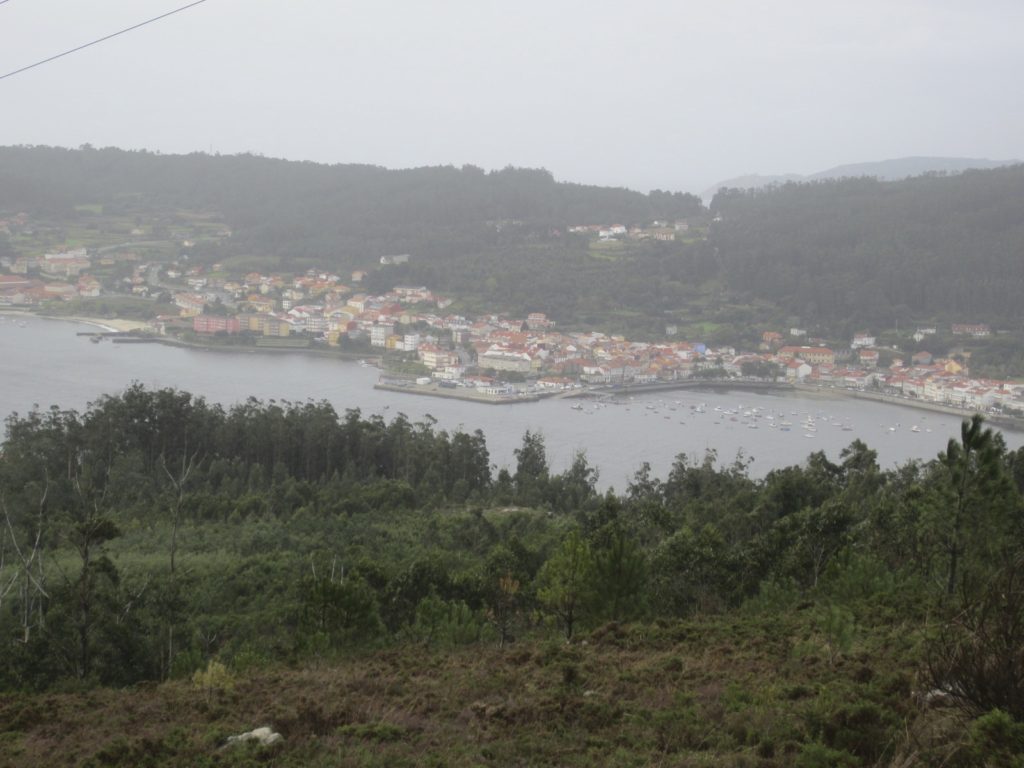
Walking by rivers, lakes or oceans, has always been a source of tranquility and reassurance for me. I’m an islander after all, and I like to be near the water. After crossing a long stretch of lonely moor, the sea rose up dramatically in front of me like an orchestra following a grand performance, while the road sharply descended towards the adjoining towns of Cee and Corcubion. Out on the horizon, barely visible through the fog, lay Cabo Fisterra, the final stopping point for many a pilgrim, and my destination for the day. It was still a long way away, and ominous storm clouds started to gather overhead. Perhaps they would pass by without dropping their load on top of me. And perhaps the 2020 election was stolen from Donald Trump as well.
In life, as on the Camino, one has to be grateful for small mercies. I had walked 20 or more kilometres that day without the heavens opening. For that, I was truly thankful. But the remaining portion of the road to Finisterre saw another unmerciful shower rain down upon me with evil intensity. I had always questioned the existence of a Divine Being, but on the road to Finisterre I was left in no doubt that there was a Diabolical one in charge of the weather, and he really had it in for me on this trek. But I was stubborn. I wasn’t going to be stopped in my tracks. I was going to get there through hell or high water, and having walked through the latter I knew that the former was pretty much the same.
TO THE LIGHTHOUSE
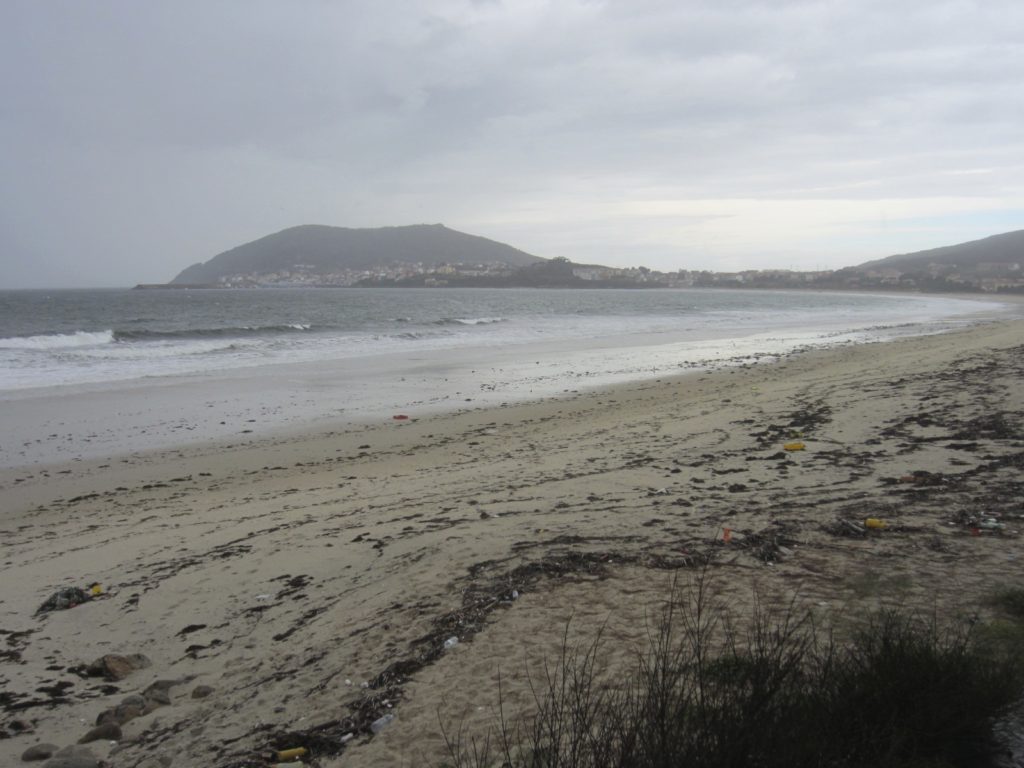
A long sandy beach, covered in shells, provides an inviting entrance to the small fishing town of Finisterre. The shell is the most prominent symbol of the Camino. It has been used by pilgrims as a makeshift container for drinking water down through the ages, while the various grooves on the shell all converge at one point, just like the different caminos all lead to Santiago. This beach is a great spot to collect a few mementos, rather than pay the inflated prices that the souvenir hawkers charge in Santiago. Many pilgrims dip their feet in the water at this beach as one of the final rituals of their pilgrimage, but as my feet were already wet enough I kept on going the short distance to the main town. With its convoluted mixture of cobbled streets and alley ways, Finisterre is a town whose modern prosperity owes a lot to its location at the terminus of the Camino. It is in turns pretty, quaint, tacky and strangely creepy. Many people like to spend a few days here to unwind after their journey. One night was enough for me.
I booked into the town’s Spartan municipal albergue, where you can also receive a beautifully illustrated certificate of your completion of this micro camino. Once all the formalities were out of the way there was only one thing left to do: follow the town’s streets as they lead to the lighthouse at the Cape’s tip. This is where the 0 KM bollard is located. Many pilgrims have traditionally commemorated the end of their journey at this place with a funeral pyre of boots and other personal items, though local authorities have put a stop to such a practice in recent times due to the damage done to the local landscape.
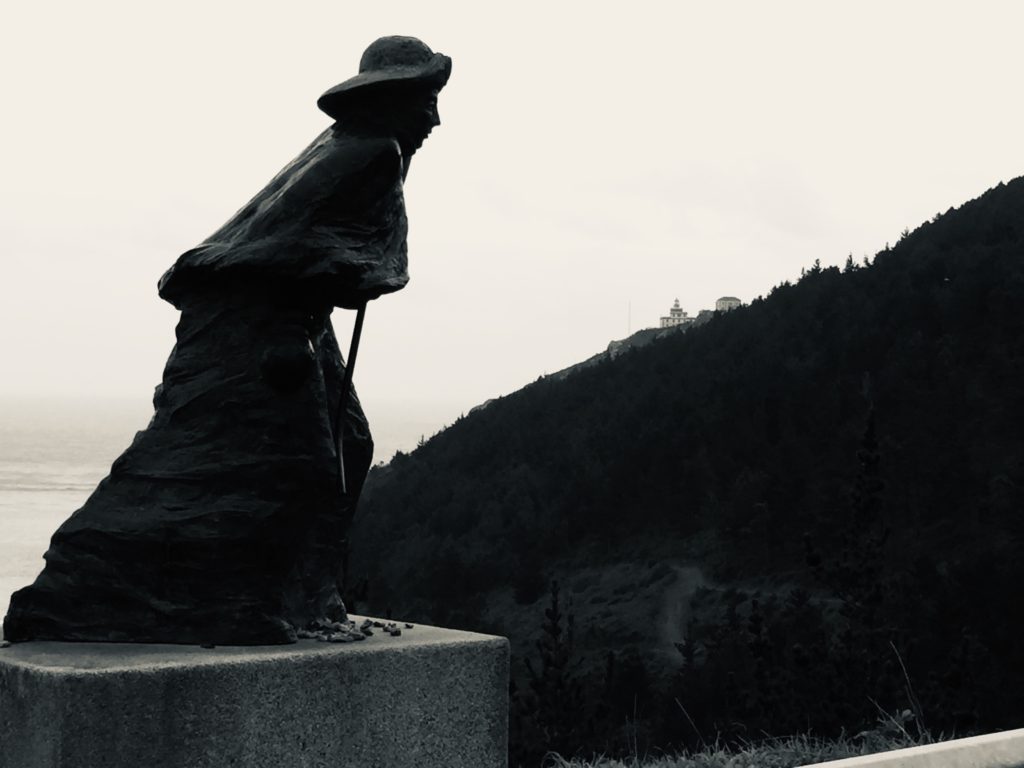
The road to the lighthouse is about 3 KM from the town, and the crowds of pilgrims have to walk along the hard shoulder which is perched above the raging ocean down below. It takes the average pilgrim about a month and a million steps to get to this point. I had lived a lifetime in the month since setting off from the Pyrenees in September 2013, just as I had when I first walked the path in 2004. My first pilgrimage profoundly shaped the twists and contours of my life over the following years, and I was drawn back to it as a way of dealing with the fact that I was crash landing into middle age, and I had to come to terms with decisions I’d made – or not made – during the first four decades of my life. If you reach a point where you need to press the reset button on your life there is no better way to do so than walk the camino.
But now that I was nearing the end, what was next? I’d surfed a roller coaster of emotions as I headed westward along the Way of St. James, finding great support and friendship from the people I had met along the way, but the road to Finisterre had been the most demanding part of this journey. The intense rain had been torture, and my endurance, stamina and sanity had all been put to the test. It would have been entirely reasonable to call it quits in Santiago a few days earlier, yet I felt it was my mission to keep on going until I reached the ocean. Now that the lighthouse was within sight, and the skies had cleared up, however temporarily, I was glad I had persevered. Perhaps I would get to see the sunset at the end of the world too.
SUNSETS AND RAINBOWS
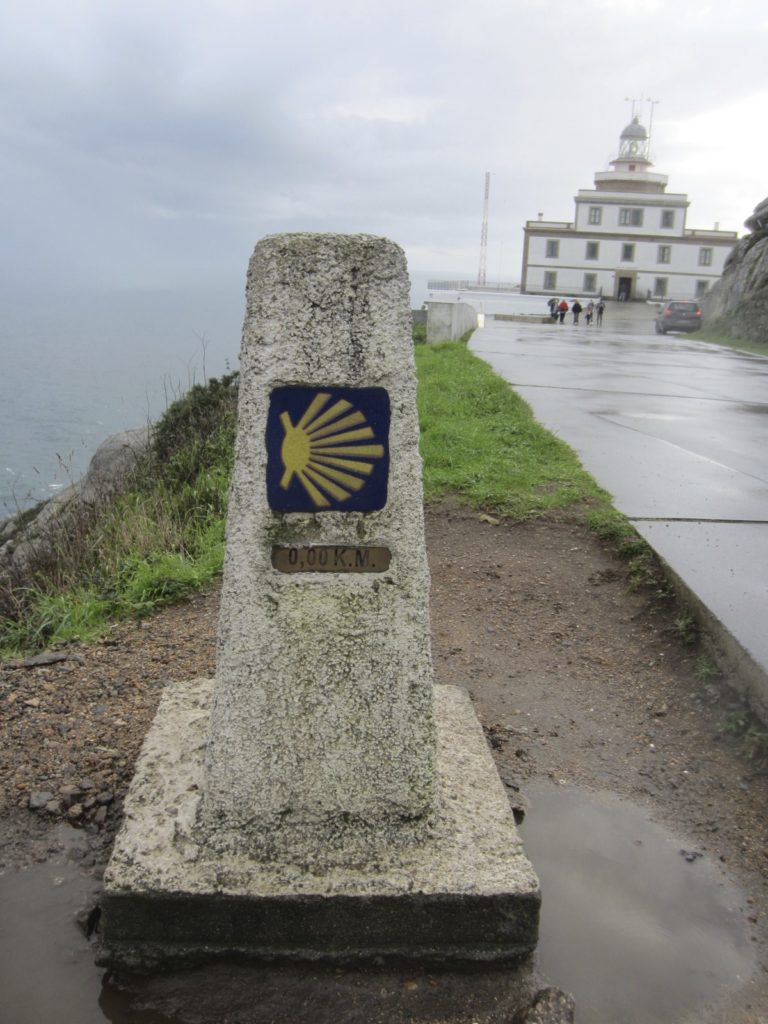
There’s always a flurry of activity on Cape Finisterre at dusk. Dozens of world weary pilgrims seek out advantageous viewing points on the cliffs below the lighthouse to catch sight of the sun setting beneath the Atlantic. Though not the most westerly point in Europe (or Spain for the matter), this point was considered to be the end of the world in ancient times. Beyond the horizon there be dragons. Though the landscape has been damaged from overcrowding, bonfires and graffiti, this is still a place that holds a mystical significance, and the sunset is a grand supernatural showstopper to perfectly top off any Camino.
I hadn’t been fortunate to witness this spectacle first time around. The Cape was shrouded in fog when I reached it. I had been looking forward to seeing a glorious sunset to bring the curtain down on my grand journey, but nature is in charge of the show, and it gets to decide who sees its charms. This time the clouds mercifully cleared, allowing sunlight and rainbows to flow through. It’s been said you can’t have rainbows without the rain. That’s true, and they’re nice and all, but on balance a few beams of multicoloured light was fairly scant consolation following the near death experience I had just been through, or the fog of depression that had followed me on every step of my journey. Then I started to think about it differently. Light is the symbol of hope, of rebirth. Nature’s little dance of luminescence, out here at the end of the world, was a way of reminding me that nothing in this world is permanent; rain always yields to sunshine, darkness to light, defeat to resilience, and despair to triumph. Light brings energy, and energy brings life. The rainbow was a sign of better things to come. It was just what I needed, after all.
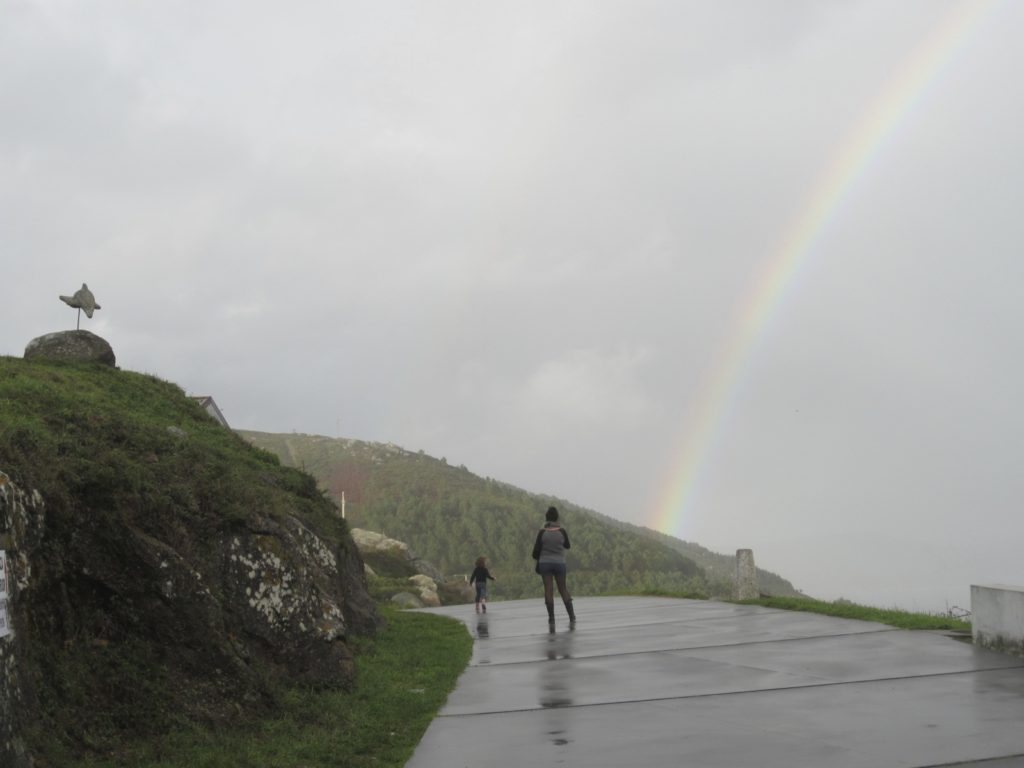
I stoically looked out at the horizon and chatted with some of my fellow pilgrims gathered nearby. Each one had travelled a long physical path to reach that point. We had all probably endured a rocky internal spiritual journey whose destination was still unknown as well. As the sun took its final bow of the day I briefly became transfixed by this sight. We are all so small in the grand scheme of things. We are but tiny little dots on a small little planet, orbiting an insignificant star that in casting its light upon us gives us life. So often we become bogged down in worries or trivialities that obscure how fortunate we are to even be here in the first place. I was miserable because I was about to turn 40, felt I had let a lot of life chances pass by, and I had recently endured for a few long walks in horrible rain. I could indulge all that stuff, or I could take stock of my life, be grateful for what I had, and keep on going. Whatever decision I took, the sun would come out the next day and in the evening would set once again at Cape Finisterre, and it wouldn’t care a damn about what I was doing. Under the circumstances there was only one choice I could make: keep on walking.
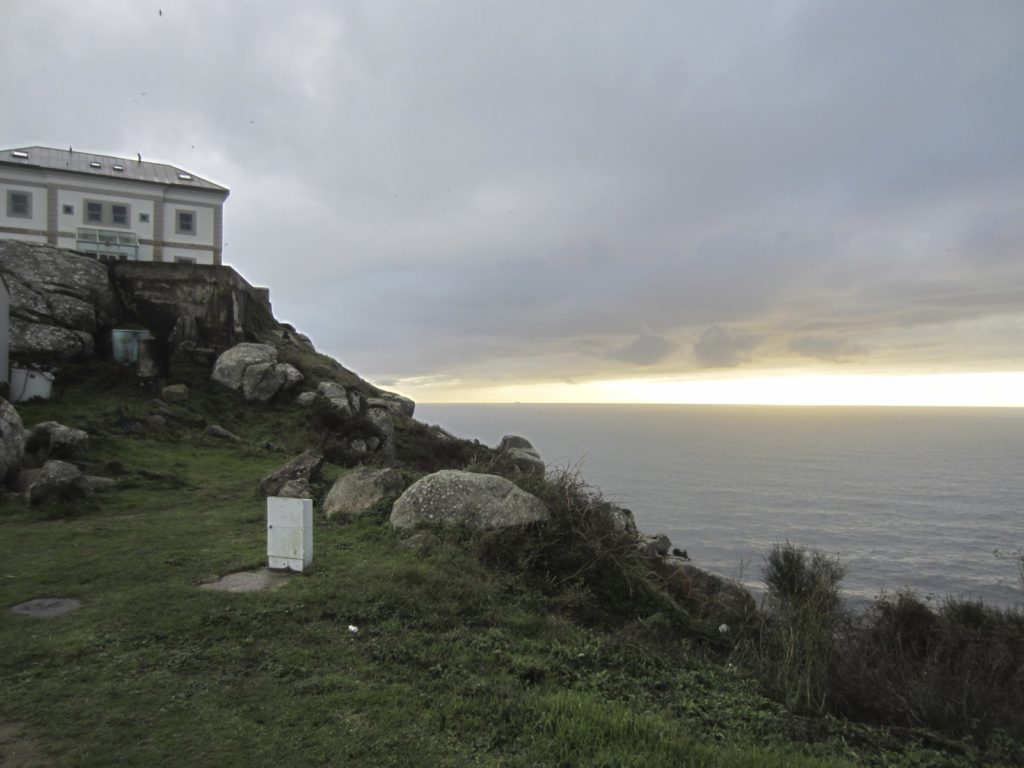
Following the twilight, I wandered back down the coastal road to Finisterre’s to meet up with my Canadian friends, Emilie and David, who had decided not to head out into the war zone the day before. Janet, our American companion who had also started out on the Camino Finisterre with us, seemed to have disappeared since the previous day. Emilie informed me plaintively that “Janet didn’t make it.” I felt pangs of sorrow as I thought one of my fellow pilgrims had been slain in the wild, but the Emilie added that she had just sought shelter in the first albergue she encountered the day before rather than battling on through the rain. I shared dinner with Emilie and David in their albergue that night, and then we said a final farewell as it was at that point that their path and mine would diverge. They were heading south to Porto but I was not finishing my walk in Finisterre. Instead I was heading one day north to a town called Muxia, and then I was planning to do an about turn and walk back to Santiago the way I had come. What would the Camino be like when doing it in reverse? I had no way of knowing. I just hoped for one thing – that it wouldn’t rain.
To be concluded.